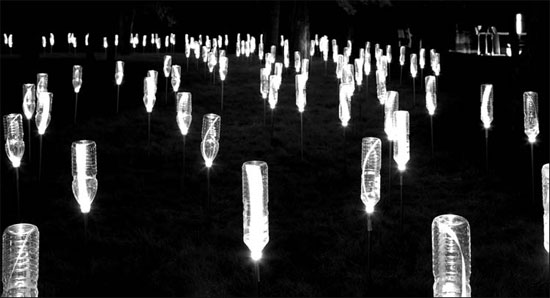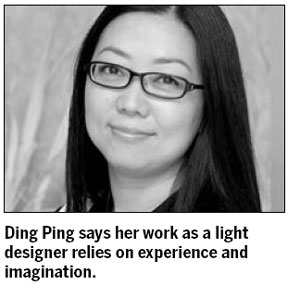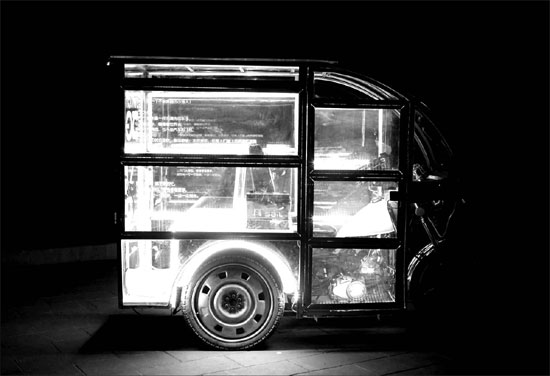In a new light
Updated: 2013-01-15 07:54
By Gan Tian (China Daily)
|
||||||||
|
Light Wheels (above) and Wishes (below), light art designs by Ding Ping. Besides architecture lighting designs, Ding is involved in art lighting shows. Photos provided to China Daily |

Gan Tian finds out there is a bright future in lighting design.
The construction of a hotel or shopping mall obviously requires architects, interior designers and landscape artists, but not many would include lighting designers in the list.
So, Ding Ping describes her job as one "few people know".
The 40-year-old is behind the LED of Beijing's Raffles City Shopping Mall and the cozy illumination of Shangri-La Hotel's lobby.
"Raffles City is young, powerful and modern, but Ritz-Carlton Hotel is traditional, quiet and elegant," Ding says.
"Consumers get their first impression from these buildings' lights."
Ding earned a degree in design management from the United Kingdom's Staffordshire University in the late 1990s. After that, she interned at professional lighting design consultancy group Lighting Design Partnership International (LDPi) in Edinburgh.
"It was a comparatively new industry then," she says.
"I could only study under a mentor or on my own."

Ding's first big project was in 2002, when she was sent by a Beijing company to rejuvenate the Shangri-La Hotel on the city's West Third Ring Road.
She used halogen lamps in the lobby because they're closer to the daylight spectrum and closer to interior decoration's original intent. She used fluorescent lamps at dinner tables and washroom sinks.
"A hotel's lighting design is very complicated. It's more like an orchestra, where there are cellos, violins and harps. Here, they are large-area lights, small-area lights, functional lights, artistic lights and so on," Ding explains.
Adjustment is also very important. The hotel's customers - mostly businessmen - don't expect a sharp contrast when they move from outside into the lobby or the meeting room. So Ding designs lights to be brighter in the daytime but dimmer at night, when customers are expecting a relaxed and cozy environment.
"So, it requires an artistic mind and logical thinking," Ding says.
But lighting design is unpredictable. Interior designers and architects use rendered pictures to illustrate their designs but a light designer relies on experience and imagination.
Beijing's Raffles City Shopping Mall was especially difficult because it has two overlapping facades, the exterior of which is glass.
"Glass can't reflect light. In this way, we are bargaining with the clients about the material. We demanded the interior should have a high surface reflectivity," Ding says.
"It varies according to the materials you use. All the designs can be illustrated by 'samples', but only lighting design can't."
But designs for such commercial spaces are only part of Ding's work.
She also does stage lighting and art shows.
The shows are installations that use reflective materials, such as steel or glass, to show artists' ideas about life.
She has initiated the Switch on Beijing International Lighting Festival three times, inviting top international lighting designers, including Andrea Momo Destro and Koert Vermeulen.
Ding showed Light Wheels there. Her work was a wheelchair, whose wheels were decorated with small lights.
She says her inspiration came from an urge to encourage a friend's 17-year-old daughter whose injuries have led her to use a wheelchair.
"Light means hope in all cultures," Ding says.
"I also hope the public will pay more attention to the disabled."
Ding says good lighting work shouldn't be "showy" and shouldn't create light pollution that affects neighbors. It should also be energy efficient.
She believes most Chinese are unfamiliar with her industry and lighting's best uses. She once conducted a survey and was disappointed to find most people in the hutong (alleyways created by traditional courtyard homes) still use only one filament lamp for large kitchens or two energy-saving bulbs in bedrooms.
"It is not because they can't afford better lights. It's because they haven't realized the importance of the use of good lights," Ding says.
Some younger people are wiser to lighting, she says.

Ding estimated that professional lighting designers are used only in 0.2 percent of the world's huge architectural projects. Lighting usually falls under the purview of interior designers.
"It will never be a mainstream design field. We are very relaxed, as we don't have many competitors globally," Ding says, laughing.
The lights in Ding's office turn on when she enters and are controlled by her movements and voice.
"Lighting design might not be the most important, but I think it brings architecture and buildings' interiors alive," she says.
Contact the writer at gantian@chinadaily.com.cn.
(China Daily 01/15/2013 page20)

 In Photos: 7.0-magnitude quake hits Sichuan
In Photos: 7.0-magnitude quake hits Sichuan
 Li Na on Time cover, makes influential 100 list
Li Na on Time cover, makes influential 100 list
 FBI releases photos of 2 Boston bombings suspects
FBI releases photos of 2 Boston bombings suspects
 World's wackiest hairstyles
World's wackiest hairstyles
 Sandstorms strike Northwest China
Sandstorms strike Northwest China
 Never-seen photos of Madonna on display
Never-seen photos of Madonna on display
 H7N9 outbreak linked to waterfowl migration
H7N9 outbreak linked to waterfowl migration
 Dozens feared dead in Texas plant blast
Dozens feared dead in Texas plant blast
Most Viewed
Editor's Picks

|

|

|

|

|

|
Today's Top News
Live report: 7.0-magnitude quake hits Sichuan, heavy casualties feared
Boston suspect cornered on boat
Cross-talk artist helps to spread the word
'Green' awareness levels drop in Beijing
Palace Museum spruces up
First couple on Time's list of most influential
H7N9 flu transmission studied
Trading channels 'need to broaden'
US Weekly

|

|








